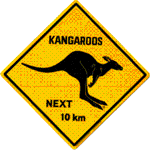|
|
|
| "If we had our time again, we would do it differently" |
| "What about the toxic, deadly creatures which we'd be sleeping with every night?" |
| "Not many places in the world have waves, huge cliffs and no pollution... and the ocean is a much darker, deeper blue." |
|
"The time has come to say fair's fair - To pay the rent, to pay the share - The time has come a fact's a fact - It belongs to them let's give it back " |
| "You know you're in the outback when what is described as a good bitumen road is in fact a single lane of tarmac with a yard or two of red dirt either side. When a car comes the other way, you plant two wheels in the dirt and hope for the best. " |
| "Flying around Australia is like taking a spaceship to Mars" |
Great
Ocean Road, Victoria
When you leave the Princess Highway from Melbourne to Geelong and when you reach Torquay, you are at the beginning of one of the most spectacular scenic coast drives in Victoria: The Great Ocean Road.
The big attraction for tourists with a few hours left is Surf World, the famous surf museum in Torquay with funny aspects of surfing and serious theory.
"Huey, the God of the Surfers, lies beneath the waves..."
Old surf boards that can't be used anymore for surfing have become letters, written from the young adventurers to their parents. They tell us the stories happening on the surfing beaches of the southern coasts. One of the boards looks really bad. "No mum, that's not the result of a crash with a shark, it just fell off the car at highway speed and the mate following hit it." If you are interested in photography there's a gallery with brief portraits of the surfing scene of the 60' and 70' (Tom Carroll, Michael Peterson etc.), put up by Jack Eden, editor of the firs surfing magazine in Australia, "Surfabout", first published in 1962.
Movies about the physical theorie of wave formations and an explanation, why different coasts get different waves and Hawaii the real big ones, forming the famous tubes, give you more specific insight. And there's an exposition of all the different surf board types for the freak, of course with all the models on display.
After you filled your brains with surfing knowledge, you enter one of the most beautiful passages of the Great Ocean Road and get a great view over stretches of sandy beaches, one of them is Bell's Beach, where all the surfers meet in April for the Surf Classics every year.
If you didn't leave Melbourne too late, you easily get to Lorne in the afternoon and can book a bed in one of the hostels. The YHA is really good, has numerous cabins with all the facilities. It's built on one of the slopes with all the lush vegetation. Cockatoos and budgerigars will wake you up in the morning if you don't raise early enough. After checking in there should be plenty of time left for the first explorations in the nearby Otway National Park or Angahook - Lorne State Park with its spectacular vegetation with lush ferns, waterfalls like the Erskine Falls and some periodic falls like the "Phantom Falls" - that's where the name comes from! If you're lucky you'll see some wild 'roos, lamas and other wildlife.
After the Phantom Falls we visit the Erskine Falls, carrying water all year. There's a hiking path from the falls back to the Coast and to Lorne. It is recommended to allow 3 hours for the distance of 7.5km and to be careful during wet conditions where water levels can raise, as you have to cross the Erskine River.
Lorne is even not halfway between Torquay and Port Campbell and there's still much to see on the way along the Great Ocea Road. Take the time to visit Cape Otway and the Otway National Park with one of the most important ligthhouses on the south coast. You are in Maits Rest, an isolated piece of rainforest that exists only because of a climatic specialty of this cape. The park consists of 13'000 hectares and is named after the first foresty officer of the area, Maitland Bryant, who used to rest his horses at this spot on the regular patrols from Apollo Bay to Hordern Vale. A wooden boardwalk has been built over the fern gully and mosscovered roots, protecting an ancient ecosystem and providing unique views of the forest for the visitor.
Continue to the Shipwerk Coast with many tragedies in its history. The wreck of Loch Ard, a three masted iron clipper ship built in Glasgow, Shotland, in 1873 is pretty famous. It had left Gravesend, England, on March 1, 1878, with 54 passengers and cargo valued at more than $ 100'000 and travelled for three months without special events as the disaster struck on June 1. Fog and haze had made it impossible for Captain Gibb to calculate a precise position into the critical zone of the Bass Strait. He believed to be safe seven miles offshore as he recognized the cliffs through the fog. The ship was mercilessly crushed against the rocks and sank within 15 minutes. People had little chance to survival and only two of them got away alive: Tom Pierce, a young member of the crew, and Eva Carmichael, travelling to visit Australia with her family.
Visit the 100m Cliffs of the Twelve Apostles in the soft evening light and stop in Port Campbell to pass the night. That gives you the possibility to continue to the Bay of Martyrs and London Bridge, which unexpectedly crashed into the sea on Januar 15, 1990, the next morning when temperatures are low and the light is fine.
< >